Introduction
Investing is a way to set aside money while you are busy with life and have that money work for you so that you can achieve your financial goals. Investing is a means to a happier ending. Legendary investor Warren Buffett defines investing as “… the process of laying out money now to receive more money in the future.” The goal of investing is to put your money to work in one or more types of investment vehicles in the hopes of growing your money over time.
What are investments? Investments are financial assets you buy with the intention of generating income or capital appreciation. It could be in the form of stocks, bonds, mutual funds, real estate, and other asset classes. Investing allows you to take advantage of the power of compounding returns and has the potential to grow your wealth over time.
Why should you invest? Investing can help you reach your financial goals, such as buying a house, saving for retirement, or building an emergency fund. Investing can also help you generate passive income, which can be used to supplement your salary and help you live a more comfortable life.

A Comprehensive Guide to Different Types of Investments
When it comes to investing, there are many different types of investments available. Here is a comprehensive guide to the different types of investments and how to choose the right one for you.
Stocks and Bonds
Stocks and bonds are two of the most common types of investments. Stocks represent ownership in a company and provide investors with a share of the profits earned by the company. Bonds are a type of loan between a company and an investor, where the investor loans the company money and receives interest payments in return.
Mutual Funds
Mutual funds are pools of money from multiple investors that are managed by professional money managers. They are a diversified way to invest in stocks, bonds, and other asset classes. Investors can buy shares of a mutual fund and benefit from the collective performance of the fund.
Exchange-Traded Funds (ETFs)
Exchange-traded funds (ETFs) are similar to mutual funds in that they are a collection of stocks, bonds, and other investments. However, ETFs trade like stocks on exchanges, meaning that investors can buy and sell them throughout the day. ETFs offer investors the convenience of investing in a broad range of securities with just one purchase.
Real Estate Investment Trusts (REITs)
Real estate investment trusts (REITs) are companies that own and operate real estate properties. Investors can buy shares of a REIT and benefit from the income generated by the trust. REITs can provide investors with a steady stream of income, as well as potential capital appreciation.
Certificates of Deposit (CDs)
Certificates of deposit (CDs) are low-risk investments issued by banks and credit unions. CDs typically have higher rates of return than savings accounts, but they require a minimum deposit and have a fixed term. CDs are a good option for investors who want to earn a guaranteed rate of return on their money.
Savings Accounts
Savings accounts are another low-risk investment option. Savings accounts offer liquidity, meaning that investors can access their money at any time. They also offer a guaranteed rate of return, albeit a relatively low one. Savings accounts are a good option for investors who want easy access to their money and a guaranteed rate of return.
Commodities
Commodities are goods that are traded on exchanges, such as oil, gold, and grains. Commodities can be a risky investment, as prices can fluctuate significantly. But they can also offer investors the opportunity to diversify their portfolios and take advantage of price movements in the commodities market.
How to Choose the Right Investment for You
Choosing the right investment for you can be a challenge, but there are some key factors to consider. First, you need to consider your financial goals. What do you want to accomplish with your investments? Do you want to save for retirement, buy a house, or build an emergency fund? Knowing your goals will help you narrow down your options.
You also need to understand your risk tolerance. Different types of investments involve different levels of risk. If you are a conservative investor, you may want to stick with lower-risk investments such as bonds and CDs. On the other hand, if you are a more aggressive investor, you may want to consider higher-risk investments such as stocks and commodities.
Finally, you need to research your options. Take the time to learn about different types of investments, their benefits and drawbacks, and how they fit into your overall investment strategy. Doing your homework will help you make informed decisions and ensure that your investments are aligned with your financial goals.

Understanding the Different Types of Investments
Now that you know how to choose the right investment for you, let’s take a closer look at each type of investment.
Stocks and Bonds
Stocks and bonds are two of the most common types of investments. Stocks represent ownership in a company and provide investors with a share of the profits earned by the company. Bonds are a type of loan between a company and an investor, where the investor loans the company money and receives interest payments in return.
Mutual Funds
Mutual funds are pools of money from multiple investors that are managed by professional money managers. They are a diversified way to invest in stocks, bonds, and other asset classes. Investors can buy shares of a mutual fund and benefit from the collective performance of the fund.
Exchange-Traded Funds (ETFs)
Exchange-traded funds (ETFs) are similar to mutual funds in that they are a collection of stocks, bonds, and other investments. However, ETFs trade like stocks on exchanges, meaning that investors can buy and sell them throughout the day. ETFs offer investors the convenience of investing in a broad range of securities with just one purchase.
Real Estate Investment Trusts (REITs)
Real estate investment trusts (REITs) are companies that own and operate real estate properties. Investors can buy shares of a REIT and benefit from the income generated by the trust. REITs can provide investors with a steady stream of income, as well as potential capital appreciation.
Certificates of Deposit (CDs)
Certificates of deposit (CDs) are low-risk investments issued by banks and credit unions. CDs typically have higher rates of return than savings accounts, but they require a minimum deposit and have a fixed term. CDs are a good option for investors who want to earn a guaranteed rate of return on their money.
Savings Accounts
Savings accounts are another low-risk investment option. Savings accounts offer liquidity, meaning that investors can access their money at any time. They also offer a guaranteed rate of return, albeit a relatively low one. Savings accounts are a good option for investors who want easy access to their money and a guaranteed rate of return.
Commodities
Commodities are goods that are traded on exchanges, such as oil, gold, and grains. Commodities can be a risky investment, as prices can fluctuate significantly. But they can also offer investors the opportunity to diversify their portfolios and take advantage of price movements in the commodities market.

Pros and Cons of Different Types of Investments
Each type of investment has its own advantages and disadvantages. It’s important to understand the pros and cons of each type of investment before making a decision.
Stocks and Bonds
The main advantage of stocks and bonds is the potential for capital appreciation. Stocks can also provide investors with dividends, which can provide a steady source of income. The main disadvantage of stocks and bonds is that they can be volatile and subject to market fluctuations.
Mutual Funds
The main advantage of mutual funds is that they are a diversified way to invest in stocks, bonds, and other asset classes. Mutual funds also offer professional management and lower fees than other types of investments. The main disadvantage of mutual funds is that they can have high fees, which can eat into returns.
Exchange-Traded Funds (ETFs)
The main advantage of ETFs is that they offer investors the convenience of investing in a broad range of securities with just one purchase. ETFs also have lower fees than mutual funds. The main disadvantage of ETFs is that they can be volatile and subject to market fluctuations.
Real Estate Investment Trusts (REITs)
The main advantage of REITs is that they can provide investors with a steady stream of income. REITs also offer potential capital appreciation. The main disadvantage of REITs is that they can be illiquid, meaning that investors may not be able to quickly access their money when needed.
Certificates of Deposit (CDs)
The main advantage of CDs is that they offer a guaranteed rate of return. CDs also have a fixed term, so investors know when they will receive their money back. The main disadvantage of CDs is that they typically have lower rates of return than other types of investments.
Savings Accounts
The main advantage of savings accounts is that they offer liquidity and a guaranteed rate of return. Savings accounts also have no minimum deposit requirement. The main disadvantage of savings accounts is that they typically have lower rates of return than other types of investments.
Commodities
The main advantage of commodities is that they offer investors the opportunity to diversify their portfolios and take advantage of price movements in the commodities market. The main disadvantage of commodities is that they can be volatile and subject to market fluctuations.
A Beginner’s Guide to Investing: What Are the Different Types of Investments?
If you’re just getting started in investing, here is a beginner’s guide to help you get started.
Getting Started
The first step is to determine your financial goals. What do you want to accomplish with your investments? Do you want to save for retirement, buy a house, or build an emergency fund? Knowing your goals will help you narrow down your options.
Building a Portfolio
Once you have determined your financial goals, you can start building your portfolio. Start by researching different types of investments and understanding their risks and rewards. Then, decide which investments are best suited to your goals and risk tolerance.
Setting Investment Goals
Once you have a portfolio in place, it’s important to set specific investment goals. These goals should be measurable and achievable. For example, you might set a goal of achieving a 10% annual return on your investments. Setting goals will help you stay motivated and keep track of your progress.
Researching Investment Options
Finally, it’s important to do your research. Take the time to learn about different types of investments, their benefits and drawbacks, and how they fit into your overall investment strategy. Doing your homework will help you make informed decisions and ensure that your investments are aligned with your financial goals.
Conclusion
Investing can be a daunting task, but it doesn’t have to be. With a little bit of knowledge and research, you can find the right investments to help you reach your financial goals. There are many different types of investments available, so take the time to understand the pros and cons of each type of investment before making a decision.
Key takeaways: Investing can help you reach your financial goals; different types of investments involve different levels of risk; do your research to understand the pros and cons of each type of investment; and set specific investment goals to stay motivated and keep track of your progress.
(Note: Is this article not meeting your expectations? Do you have knowledge or insights to share? Unlock new opportunities and expand your reach by joining our authors team. Click Registration to join us and share your expertise with our readers.)
